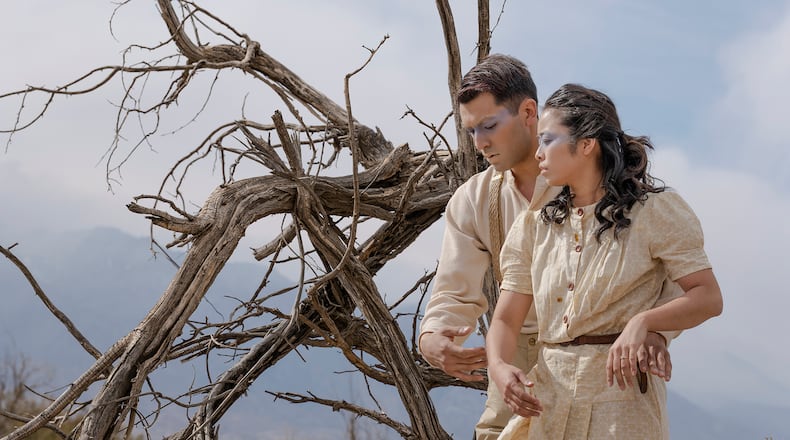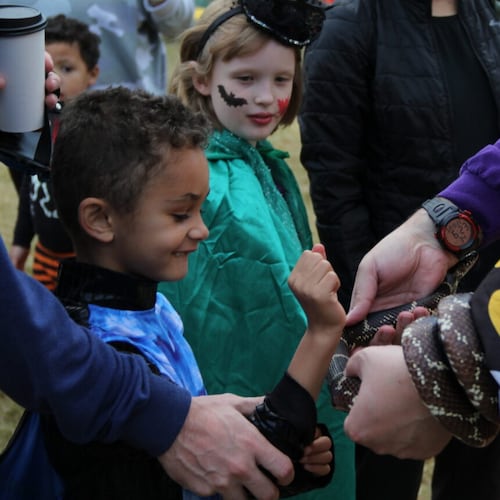Manzanar, historic site of a camp where 10,000 Japanese Americans were illegally incarcerated during World War II, is remote for a reason — four hours by bus from San Francisco, and about six hours from Los Angeles without traffic.
In 2019, it was the site of the 50th anniversary of an annual pilgrimage. Under the scorching sun, more than 2,000 people gathered to commemorate a pilgrimage that has taken place annually since the 1970s. Taiko drummers played as thousands of people formed a circle and danced together joyfully, stepping and clapping to a common beat.
In attendance was Yayoi Kambara, artistic director of the San Francisco-based dance company KAMBARA+.
“It was chilling,” Kambara said. “So many people have done this dance here for so long, so we don’t forget these tragedies and these horrors, because we just can’t let that happen again.”
As she danced, Kambara was struck by the power of dance to reconcile history. Through dance, people could move through trauma, move through challenges, she said, “so we can get to the other side.”
This experience inspired Kambara to create “Sankei.” A trio of works using live performance, film and interactive digital technology, it reflects on ancestral joy, historical trauma and community resilience in a way that’s specific to Japanese American culture and universally relevant.
Credit: Bruce Ghent
Credit: Bruce Ghent
“Sankei” opens Sept. 16 with the dance performance “IKKAI Means Once: A Transplanted Pilgrimage.” A six-week exhibition follows, featuring Kambara’s the “Out of the Dust” and the interactive installation “NI DO TO: An XR Pilgrimage.” All three components of “Sankei” are presented by Georgia Tech Arts at the Ferst Center for the Arts.
A Japanese born, naturalized U.S. citizen, Kambara performed extensively with the San Francisco-based ODC/Dance Company and has worked in opera, film and as a museum curator. She’s also a mom.
Seven years ago, her eldest daughter asked about Black Lives Matter posters she saw around San Francisco. To explain racial inequality to the 8-year-old child, Kambara brought the concept home, explaining that if their family had been alive during World War II, they would have been sent to an internment camp.
Following the Japanese attack on Pearl Harbor in 1941, President Franklin D. Roosevelt authorized the government to remove anyone of Japanese ancestry on the West Coast to internment camps where they remained for three years until the end of the war. People had few days to prepare to leave their homes and jobs behind and were allowed to bring only a few possessions with them.
The conversation with her daughter inspired Kambara to explore this fading history through dance performance and to better represent Asian American stories on the concert dance stage. She set out on an epic bus trip to Manzanar where she toured the barracks in which families were forced to live.
“We’d have these amazing elders that were in their 80s walk around Manzanar and say, ‘I remember something that my mom said to me, and I remember holding her hand and having to walk to the latrine in the middle of the night.’”
Credit: Deeksha Prakash
Credit: Deeksha Prakash
Those stories and the powerful group healing she felt while dancing at Manzanar inspired her choreography for the live performance “IKKAI Means Once.” The work blends the old with the new by combining contemporary and traditional Japanese dance set to poetry by Janice Mirikitani, a sound score with Taiko drumming designed by Miles Lassi and music composed by Paul Chihara.
“IKKAI” traces a chronological timeline from prosperous pre-war days to a period of surveillance and then incarceration, followed by the return to society. Within that framework, Kambara explores her characters’ emotional journeys.
“How can we be a teenager and still be surveilled and be tremendously stressed out and still going to prom?” Kambara asked. “How was a marriage still strong after being incarcerated, where there’s no privacy? And at the same time, how is it terribly violent because of the pressures of being incarcerated?”
Kambara was planning to debut “IKKAI” as just a live performance piece in 2023. Then the pandemic happened, and new ways to present dance in digital platforms were created. The project that started as a single idea spawned two additional components with potential to reach more audiences.
Working with Aaron Shackelford, then director of Georgia Tech Arts, Kambara and her producer Courtney Ozaki attended a weeklong residency with CRUX, an immersive storytelling cooperative in New Mexico. They studied how Virtual Reality, Augmented Reality and Mixed Reality could amplify social justice messages through artistic and cultural expressions.
Out of that came “NI DO TO: An XR Pilgrimage.” The interactive installation, designed for the Ferst Center lobby, uses immersive technologies to give visitors a fully embodied experience, inspired by Kambara’s pilgrimage to Manzanar.
Visitors to “NI DO TO” can migrate through four stations that use technology to explore themes of displacement and resilience.
At one station, visitors can learn a traditional Obon circle dance from holographic images of two Japanese dancers. An AI camera picks up participants’ movements and abstracts them into colors and forms that are projected onto a screen. Among the images are birds and flowers — symbols of life, death and rebirth.
At another station, a video game simulates the choices Japanese Americans had to make when packing quickly as they left their homes for the camps. Elsewhere, visitors can make origami fortune tellers and take them or leave them as part of an interactive installation. And a poetry machine, based on the design of a coin-operated Zoltar fortune teller machine, will recite the late San Francisco Poet Laureate Janice Mirikitani’s reflections on her internment as a child and will invite visitors to write their own reflections as they leave.
Directed by Brian Staufenbiel and choreographed by Kambara and the cast, the dance film “Out of the Dust” brings the choreography and music of “IKKAI Means Once” to Manzanar where it’s performed on the bleak landscape.
As the racial reckoning that followed the pandemic exposed stark social inequities, Kambara hopes “Sankei” helps viewers work out questions of how we come back together, knowing what we do now.
“It works if we can all move together towards the same goals,” said Kambara.
She envisions the circular folk dance she experienced at Manzanar and the Obon dance visitors will experience in “Sankei” as metaphors for gathering together with open minds, “for committing to never letting child incarceration happen again,” she said, and “towards dreaming of a more equitable future for everybody.”
Dance Preview
“Sankei.” “IKKAI Means Once: A Transplanted Pilgrimage.” Live performance. 8 p.m. Saturday, Sept. 16. $10-$25. “NI DO TO: An XR Pilgrimage” and “Out of the Dust.” Installation and film. 9 a.m.-6 p.m., Tuesday-Saturday, Sept. 18-Oct. 27 (closed Sept. 30 and Oct. 21). Free. Presented by the dance company KAMBARA+ and Georgia Tech Arts. Ferst Center for the Arts, 349 Ferst Drive NW, Atlanta. 404-894-9600. arts.gatech.edu
About the Author
Keep Reading
The Latest
Featured



